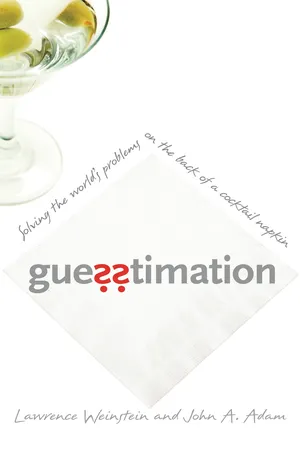
Guesstimation
Solving the World's Problems on the Back of a Cocktail Napkin
- 320 pages
- English
- ePUB (mobile friendly)
- Available on iOS & Android
Guesstimation
Solving the World's Problems on the Back of a Cocktail Napkin
About this book
Guesstimation is a book that unlocks the power of approximation--it's popular mathematics rounded to the nearest power of ten! The ability to estimate is an important skill in daily life. More and more leading businesses today use estimation questions in interviews to test applicants' abilities to think on their feet. Guesstimation enables anyone with basic math and science skills to estimate virtually anything--quickly--using plausible assumptions and elementary arithmetic.
Lawrence Weinstein and John Adam present an eclectic array of estimation problems that range from devilishly simple to quite sophisticated and from serious real-world concerns to downright silly ones. How long would it take a running faucet to fill the inverted dome of the Capitol? What is the total length of all the pickles consumed in the US in one year? What are the relative merits of internal-combustion and electric cars, of coal and nuclear energy? The problems are marvelously diverse, yet the skills to solve them are the same. The authors show how easy it is to derive useful ballpark estimates by breaking complex problems into simpler, more manageable ones--and how there can be many paths to the right answer. The book is written in a question-and-answer format with lots of hints along the way. It includes a handy appendix summarizing the few formulas and basic science concepts needed, and its small size and French-fold design make it conveniently portable. Illustrated with humorous pen-and-ink sketches, Guesstimation will delight popular-math enthusiasts and is ideal for the classroom.
Frequently asked questions
- Essential is ideal for learners and professionals who enjoy exploring a wide range of subjects. Access the Essential Library with 800,000+ trusted titles and best-sellers across business, personal growth, and the humanities. Includes unlimited reading time and Standard Read Aloud voice.
- Complete: Perfect for advanced learners and researchers needing full, unrestricted access. Unlock 1.4M+ books across hundreds of subjects, including academic and specialized titles. The Complete Plan also includes advanced features like Premium Read Aloud and Research Assistant.
Please note we cannot support devices running on iOS 13 and Android 7 or earlier. Learn more about using the app.
Information
Chapter 1
How to Solve Problems
- too big
- too small
- just right


EXAMPLE 1: MongaMillions Lottery Ticket Stack


EXAMPLE 2: Flighty Americans


EXAMPLE 3: Piano Tuners in Los Angeles
- population of Los Angeles
- proportion of pianos per person
- how often each piano is tuned per year
- how much time it takes to tune each piano
- how much time each piano tuner works per year
- The population of Los Angeles must be much less than 108 (since the population of the US is 3 × 108). It must be much more than 106 (since that is the size of an ordinary big city). We’ll estimate it at 107.
- Pianos will be owned by individuals, schools, and houses of worship. About 10% of the population plays a musical instrument (it’s surely more than 1% and less than 1...
Table of contents
- Cover
- Title Page
- Copyright
- Dedication
- Contents
- Acknowledgments
- Preface
- Chapter 1: How to Solve Problems
- Chapter 2: Dealing with Large Numbers
- Chapter 3: General Questions
- Chapter 4: Animals and People
- Chapter 5: Transportation
- Chapter 6: Energy and Work
- Chapter 7: Hydrocarbons and Carbohydrates
- Chapter 8: The Earth, the Moon, and Lots of Gerbils
- Chapter 9: Energy and the Environment
- Chapter 10: The Atmosphere
- Chapter 11: Risk
- Chapter 12: Unanswered Questions
- Appendix A: Needed Numbers and Formulas
- Appendix B: Pegs to Hang Things On
- Bibliography
- Index